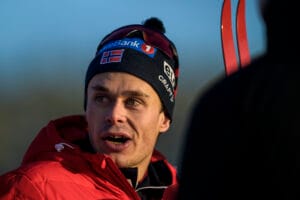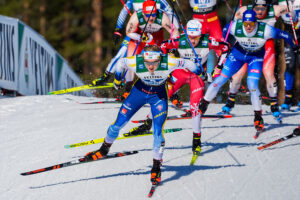Expert coach warns: Are you falling into the training trend trap?
A former national team coach fears the consequences of the training trend that many cross-country skiers have gotten carried away with.
Former national team coach Geir Endre Rogn has noticed that more and more cross-country skiers are now embracing the trend of high-intensity blocks and double-hard training sessions. Training trends and training plans based on intensity blocks and double or frequent hard sessions are among those that appear regularly.
“There have been several such intensity waves in the past, and we’re in a similar period now. This last one has built up over the last few years, especially in the Lillehammer area, but also inspired by athletics and triathlon,” says Rogn, who was coach of the elite women’s national cross-country skiing team until 2020.
Rogn now does training guidance and follow-up for athletes through his company topptrent.com, and has noticed that many elite athletes are curious about the trend of intensity blocks – even this time.
He fears that it will have a negative impact on many and warns against jumping on the ‘rain’ uncritically.
Why stop using intensity blocks?
“The reason for abandoning such intensity blocks is that the risk is too great. There will be many people left in the ditch after this wave,” says Rogn to Langrenn.com, and adds:
“It’s been long enough since the last time we had such an intensity block wave, and we’ve forgotten how many people burned themselves out on this type of program. Bjørgen is perhaps the most striking example from the last wave, which ravaged the years around 2005.”
The article continues below.

Going well for a while
Rogn explains that the total load over time makes it difficult to make such programs successful in the long run.
“It requires incredible precision and discipline from the athlete, and a lot has to be put in place around the athlete to succeed. It’s all about the big picture, and you must pay close attention to the whole package so that the total load is not too great,” he says.
“We see that the athlete can develop well for a while, but it’s difficult to keep up with this type of program over a long period of time and through several seasons. This affects the quality of each hard session and the rest of the training,” says Rogn.
Read More: The training that brought Northug back to the top
Inspired by research, athletics – and Ingebrigtsen
Rogn believes that the research community in Lillehammer, led by Inland Norway University of Applied Sciences, is part of the reason why a new trend for high-intensity training is now emerging among athletes in that region.
They tend to train many hard sessions in blocks, for example, seven hard sessions in five days, followed by a period of traditional training with a combination of hard sessions and easy long runs.
“It’s easier in a trial project or for athletes in teams where training is very controlled. It often works well in the first season so that it can work for a while, but it’s challenging to maintain this over time,” says Rogn.
He sees that the reports on the researchers’ results, combined with the success of Norwegian athletes and especially the Ingebrigtsen brothers in running and their double hard sessions as the basis for their training program, means that more and more cross-country skiers are curious about this type of training.
“It’s easy to look at the Ingebrigtsen brothers and want to try it. What they do is not shorter, time-limited periods with an increased focus on hard sessions. They run a more continuous program with a lot of hard sessions all the time, but not so large or strenuous intervals,” says Rogn, and points out that running and cross-country skiing are two different sports.
The article continues below.

“I think the approach they (the Ingebrigtsen brothers) use works better in the running than cross-country skiing. In running, threshold speed is crucial, and you have more to gain from emphasizing training time on competition speed. But I’m doubtful that such an approach will work well as a sustained regime throughout a cross-country skier’s career,” says Rogn, and explains:
“Cross-country skiing is a far more complex sport, both in terms of variation in intensity, terrain, and techniques. Therefore, history has shown that a higher amount of training and more variety is what works best for a cross-country skier over time.”
Also Read:
Training trends: Ski sessions inspired by Van der Poel, Ingebrigtsen and triathlon
Training trends: What can cross-country skiers learn from other sports?
The article continues below.

However, Rogn is no stranger to adding periods with a greater focus on hard sessions or trying new training models.
“I’m not negative about periods with more hard sessions, but history shows that many people burn themselves out on such intensity blocks if it becomes too extreme and there is too much time between them. It’s good to experiment and seek new impulses, but I’m afraid it’s easy to take this a little too far,” says Rogn.
“For most people, it will be more important to ensure that you get the most out of each hard session than to have as many of them as possible,” the experienced coach points out.
Must be used purposefully
At the same time, Rogn emphasizes that it is also common in traditional training programs for cross-country skiers to include periods where hard sessions are prioritized. A significant difference from the trend of intensity blocks is that in traditional training programs, the intensity periods are not part of the norm but are used specifically and purposefully.
“For example, it is natural to include periods with more intervals before and after altitude sessions because it is more difficult to train intensity at altitude. For those who do not use altitude training systematically, you can still use blocks with more hard sessions as a natural part of the training periodization,” he says.
Geir Endre Rogn concludes by reminding us that hard sessions are, of course, important but that they are only part of a comprehensive training program.
“Feel free to run periods with more hard sessions, but make sure that the periods are well integrated into the training plan and are not too extreme so that you also get enough training in all the other areas to make you the best possible cross-country skier over time.”
Are you interested in training? Click HERE and read more.










